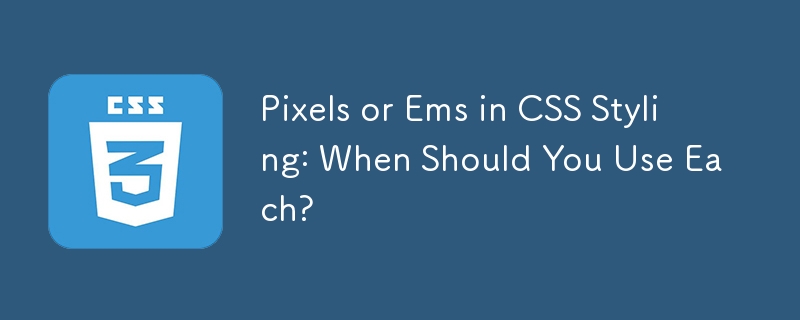Pixels or Ems in CSS Styling: When Should You Use Each?

Why Use Em or Px When Styling CSS?
While it is mentioned that em is preferable to px for defining styles, it is crucial to understand the distinction between these units and their appropriate usage.
Definition of Units
- px (pixels): An absolute unit, where 1 px represents 1/96 of an inch. Absolute units do not scale.
- em: A relative unit, where 1 em represents the size of the current font. It scales proportionally with font size changes.
- rem (root em): Similar to em, but it is relative to the base font size of the entire document.
- % (percentage): Another relative unit, relative to the height or width of the parent element. It allows elements to adjust their size based on the parent's dimensions.
- vh, vw, vmin, vmax (viewport units): Units relative to the viewport (the visible area of the browser window) rather than the parent element.
Appropriate Usage
Contrary to the notion that one unit is superior, each has its specific uses:
-
Use px for:
- Fixed-size elements (such as images, banners, icons, borders)
- Precise font sizing
-
Use em for:
- Elements that should scale with the font size (e.g., line spacing, margins)
-
Use rem for:
- Elements that should scale with the base font size of the document
-
Use % for:
- Elements that should adapt to the size of the parent element
- Creating layouts that adjust to different screen sizes
-
Use viewport units for:
- Elements that should scale with the viewport size (e.g., header size, full-screen elements)
Conclusion
Choosing between em and px or other units depends on the desired effect. Absolute units like px provide fixed sizing, while relative units like em and % allow for dynamic scaling. Understanding the purpose and use cases of each unit is essential for effective CSS styling.
The above is the detailed content of Pixels or Ems in CSS Styling: When Should You Use Each?. For more information, please follow other related articles on the PHP Chinese website!

Hot AI Tools

Undresser.AI Undress
AI-powered app for creating realistic nude photos

AI Clothes Remover
Online AI tool for removing clothes from photos.

Undress AI Tool
Undress images for free

Clothoff.io
AI clothes remover

AI Hentai Generator
Generate AI Hentai for free.

Hot Article

Hot Tools

Notepad++7.3.1
Easy-to-use and free code editor

SublimeText3 Chinese version
Chinese version, very easy to use

Zend Studio 13.0.1
Powerful PHP integrated development environment

Dreamweaver CS6
Visual web development tools

SublimeText3 Mac version
God-level code editing software (SublimeText3)

Hot Topics
 1384
1384
 52
52
 Working With GraphQL Caching
Mar 19, 2025 am 09:36 AM
Working With GraphQL Caching
Mar 19, 2025 am 09:36 AM
If you’ve recently started working with GraphQL, or reviewed its pros and cons, you’ve no doubt heard things like “GraphQL doesn’t support caching” or
 Building an Ethereum app using Redwood.js and Fauna
Mar 28, 2025 am 09:18 AM
Building an Ethereum app using Redwood.js and Fauna
Mar 28, 2025 am 09:18 AM
With the recent climb of Bitcoin’s price over 20k $USD, and to it recently breaking 30k, I thought it’s worth taking a deep dive back into creating Ethereum
 Vue 3
Apr 02, 2025 pm 06:32 PM
Vue 3
Apr 02, 2025 pm 06:32 PM
It's out! Congrats to the Vue team for getting it done, I know it was a massive effort and a long time coming. All new docs, as well.
 Creating Your Own Bragdoc With Eleventy
Mar 18, 2025 am 11:23 AM
Creating Your Own Bragdoc With Eleventy
Mar 18, 2025 am 11:23 AM
No matter what stage you’re at as a developer, the tasks we complete—whether big or small—make a huge impact in our personal and professional growth.
 Can you get valid CSS property values from the browser?
Apr 02, 2025 pm 06:17 PM
Can you get valid CSS property values from the browser?
Apr 02, 2025 pm 06:17 PM
I had someone write in with this very legit question. Lea just blogged about how you can get valid CSS properties themselves from the browser. That's like this.
 A bit on ci/cd
Apr 02, 2025 pm 06:21 PM
A bit on ci/cd
Apr 02, 2025 pm 06:21 PM
I'd say "website" fits better than "mobile app" but I like this framing from Max Lynch:
 Comparing Browsers for Responsive Design
Apr 02, 2025 pm 06:25 PM
Comparing Browsers for Responsive Design
Apr 02, 2025 pm 06:25 PM
There are a number of these desktop apps where the goal is showing your site at different dimensions all at the same time. So you can, for example, be writing
 Stacked Cards with Sticky Positioning and a Dash of Sass
Apr 03, 2025 am 10:30 AM
Stacked Cards with Sticky Positioning and a Dash of Sass
Apr 03, 2025 am 10:30 AM
The other day, I spotted this particularly lovely bit from Corey Ginnivan’s website where a collection of cards stack on top of one another as you scroll.




